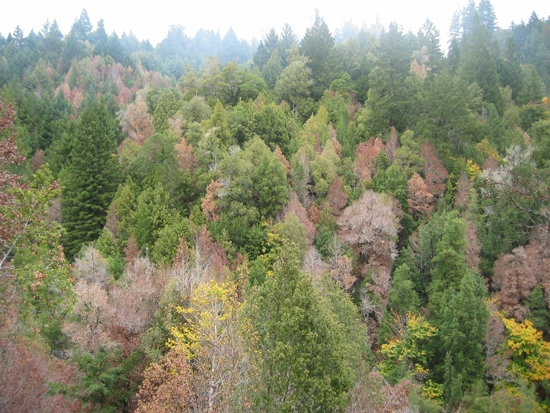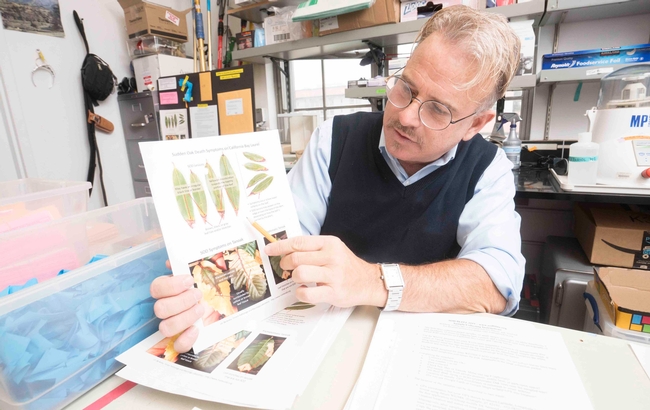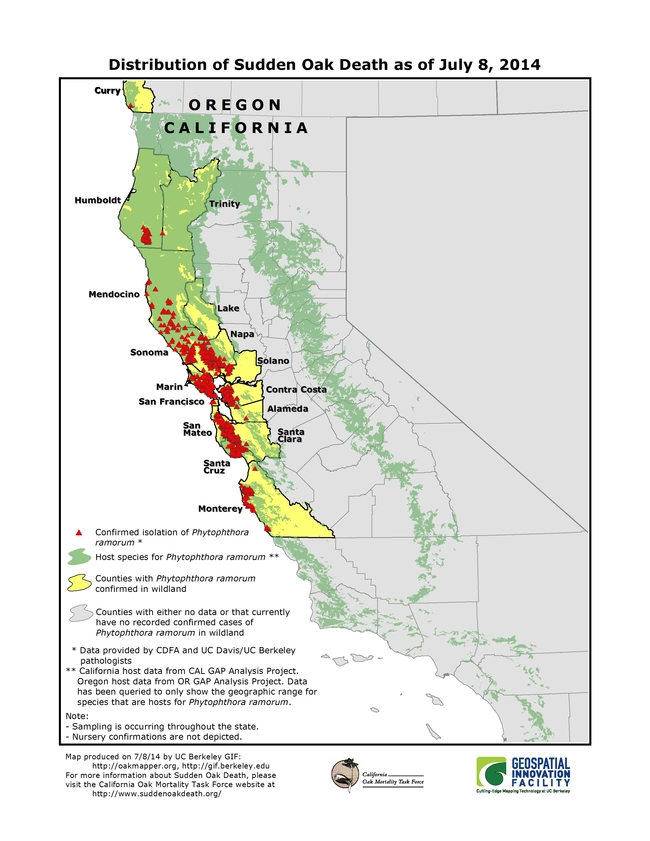Posts Tagged: SOD
2019 SODBlitz shows Sudden Oak Death on the rise in California
Sudden Oak Death (SOD), a serious exotic tree disease, threatens the survival of tanoak and several oak species in California. Currently, SOD infects trees in 14 coastal California counties, from Monterey to Humboldt. The disease, which was estimated to have killed over 50 million oaks and tanoaks over two decades, has changed the coastal forests composition in Northern California and Southern Oregon.
Though SOD occurs in patches, the overall infection area continues to grow with each passing year. Researchers had previously discovered that Phytophthora ramorum, the pathogen that causes SOD, most often spreads on the leaves of infected California bay laurel and tanoak. Forest managers can use proactive methods for controlling the disease — including sanitation, chemical treatments, and the targeted removal of bay trees — but such tools are preemptive in nature, only useful before oaks and tanoaks are infected. Timely detection of the disease in these species is therefore critical to slowing the epidemic.
With this in mind, UC Berkeley joined with over 30 local organizers in 2019 to assemble 25 SOD Blitzes staffed by trained volunteers. More than 400 volunteers were taught to identify SOD symptoms and to carefully collect symptomatic leaves from California bay laurels and tanoaks. Armed with this training, the teams surveyed 16,227 trees across 16 California counties, collecting approximately 9,000 leaves from 1,732 symptomatic trees. Samples were sent to the UC Berkeley Forest Pathology and Mycology Laboratory for processing and analysis.
The benefits of SOD Blitzes are becoming increasingly clear. Importantly, they educate the community about Sudden Oak Death, getting locals involved in detecting the disease while creating detailed maps of infected areas. Analyses of these maps help forest managers figure out where proactive measures, such as chemical treatments or tree removal, most effectively stop an infestation. All results from the data collection are made publicly available on SODBlitz.org, SODMap.org, and on the SODmap mobile app available at the Apple Store and at Google Play. (Results can also be accessed directly on the UC Berkeley Forest Pathology and Mycology Laboratory website.)
Using the app allows anyone to estimate the risk of oak infection, specific to their current location. While standing next to a tree of interest, a person can tap the app's “RISK” button and determine whether an oak is in danger of contracting SOD. In addition, results meetings and treatment training workshops will be held for the public in various Bay Area locations during fall 2019.
Matteo Garbelotto, UC Cooperative Extension specialist and adjunct professor in the Department of Environmental Science, Policy, and Management, has led the SOD Blitzes for 12 years. The program enrolls approximately 500 volunteers yearly to canvas California woodlands for symptoms of SOD. Results of the surveys are made available nearly in real-time, immediately after completion of the lab analysis.
“We estimate that as many as two to three million people may have accessed the SOD Blitz results to determine whether trees on their property may be at risk,” Garbelotto said. “This is a huge success and shows the great societal value that citizen science has, and it highlights the importance of collaborating with volunteers on issues that are relevant to safeguard trees that are an important part of California's natural heritage.”
2019 SOD Blitz Results
Across the state, the number of trees infected with SOD, along with the estimated SOD infection rate, has almost doubled since 2018. In some areas, infection rates were as much as 10 times higher than the previous year. These results suggest that the overall risk of oak infection by SOD is rising.
Spikes in the estimated SOD infection level at certain locations are particularly noteworthy; for example, from 1 to 12 percent in the western part of the East Bay between Richmond and San Leandro, including distinct outbreaks discovered in El Cerrito, Kensington and Berkeley. The western slopes of the Santa Cruz Mountains in San Mateo County have also seen an increase in SOD infection rate (from 6 to 18 percent), which may make safeguarding recreational venues and ecologically important forest sites more difficult. In Sonoma County, the 2019 SOD infection rate was approximately double that of 2018, and in the same timeframe, Napa saw a fourfold increase in detection. Peninsula towns between Redwood City and Los Altos Hills had a very high infection rate (21.6 percent) with an expansion of outbreaks to the east and north.
Some additional key results that came from the 2019 SOD Blitzes include:
- Two tanoaks were positive for SOD in a state park east of Crescent City in Del Norte County, marking the first report of SOD for the county. This was an important finding because, until 2019, Del Norte was the only county free of the disease in the area between the vast California infestation and the Southern Oregon outbreak. The SOD Blitz finding does not have immediate implications for regulations, but regulations will be imposed once CDFA can confirm the finding.
- An extensive survey of San Luis Obispo failed to identify SOD; however, multiple trees were found to be infected in the southernmost canyon of Monterey County. Previously, this canyon had only provided positive findings from water monitored by UC Davis scientists, but not from trees.
- Although Humboldt County has a few significant SOD outbreaks, and Trinity County has a marginal SOD outbreak in its southwestern border, SOD Blitzes in tribal lands in Humboldt and Trinity counties did not yield any SOD positives.
- San Francisco parks, including the Presidio, were negative for a second year in a row, suggesting that disease management practices have been successfully implemented in the area.
- Several cases were identified in the northern neighborhoods of the City of Napa. No positives had been found in this area since 2011.
- All isolates of the pathogen belonged to the NA1 lineage, which is more easily treated and common in the region. This is good news because of uncertainty about the potential virulence of the EU1 lineage recently discovered in Oregon forests.
A sampling of other noteworthy 2019 SOD Blitzes results follow. More results are available on the websites and app:
- The first infected Bay laurel was identified a few miles east of the town of Mendocino (Mendocino County) along the Comptche-Ukiah Road.
- Multiple SOD positive trees were identified between Guerneville and Duncan Mills in Sonoma County. The Russian River area has long been known to be affected by SOD.
- An outbreak was identified in southwestern Petaluma, while infestations were confirmed in Bennett Valley, Santa Rosa and east of Rohnert Park.
- Multiple infestations were identified in Marin County, including the ones northeast of San Rafael, Larkspur, Woodacre, Mount Tamalpais, Marin City and north of Inverness.
- In the Peninsula, SOD was identified in Burlingame Hills, northern Woodside, Emerald Hills, Palomar Park, Portola Valley. In Los Altos Hills and Loyola, SOD positive trees were detected both East and West of Interstate 280. An outbreak was detected west of Saratoga.
- High levels of infection were identified all along Skyline between Bear Gulch Road and Highway 17, and on the western slopes of the Santa Cruz Mountains between Skyline and Pescadero.
- SOD was confirmed between Felton and Santa Cruz and between Aptos and Santa Cruz.
- In Monterey County, the chronic Big Sur outbreak was once again confirmed to be active, while the disease appeared also in drier areas of the Carmel Valley, where it had been absent for a few years.
The SOD Blitz program was funded in part by the U.S. Forest Service's State and Private Forestry Organization and by the Midpeninsula Regional Open Space District. It was also made possible by a collaboration with the California Native Plant Society, CalFire, the Humboldt/Del Norte and Sonoma County UC Cooperative Extension, the Sonoma County UC Master Gardeners, the U.S. National Parks, California State Parks, the East Bay Regional Parks, the San Francisco Public Utility Commission, Mid-Pen Open Space, the UC Santa Cruz Arboretum, Santa Cruz Open Space, the Santa Lucia Conservancy, the Karuk and Hoopa Nations, the Mendocino Botanical Garden, the City and County of San Francisco Parks and Recs Office, and Strybing Arboretum. Many individuals, who have generously devoted their time and efforts, have been pivotal for the existence and success of the program.
READ MORE:
- Matteo Garbelotto: Leading the citizen science contagion
- First known cases of sudden oak death detected in Del Norte County
- SOD Blitz Project
- SOD Blitz map of results and summary table
Sudden oak death still a threat and still spreading

Joyce interviewed Yana Valachovic, a forest advisor for UC Agriculture and Natural Resources in Humboldt and Del Norte counties. Valachovic is also director of the UC ANR Cooperative Extension offices in Humboldt and Del Norte.
"For me, the challenge is communicating to the public the disease has not gone away; in fact, it's actually getting substantially worse," Valachovic said.
Sudden oak death is caused by the pathogen Phytophthora ramorum. Currently less than 2 percent of Humboldt County's 2.25 million acres of forest are impacted by sudden oak death. But the average annual rate of expansion per year is 3,500 acres, Valachovic said. One challenge related to containing the disease is the structure of California forest agencies.
"The wildlands of California don't have a single agency that's responsible for controlling invasive introductions," she said. "Secondarily, there is no funding source that is set aside to manage these kind of epidemics. And so everything is piecemealed together: piecemealed responsibility, piecemealed in funding to address these issues."
Furthermore, Forest Service funds can only be used for monitoring, containment and education.
Joyce concluded the story with a question: "How will we learn more about this disease that is spreading through our forests at a clip of about 5 miles per year?"
Read more about sudden oak death on the California Oak Mortality Task Force website.
Drought is slowing the spread of sudden oak death

"If we had one more year of drought, it would really be ideal," said Matteo Garbelotto, UC Cooperative Extension specialist in the Department of Environmental Science, Policy and Management at UC Berkeley.
The article said Garbelotto isn't hoping for more drought, but evidence shows that the drought is helping reduce SOD infection rates and in some cases is curing infected trees, "because the pathogen dies."
Each spring, the UC Berkeley SOD lab hosts a "blitz" to gauge the spread of Sudden Oak Death. Volunteers fan out across areas susceptible to SOD and collect leaf samples for analysis.
In the Cloverdale area, where an outbreak was confirmed last year, none of the trees sampled had the disease this year, the article reported.
"I would say it is there, but we just didn't find it," Garbelotto said.
East of Highway 101, the rate dropped from 26 percent infected last year to 23.3 percent in 2014, the story said.
Complete SOD blitz results will be available Sept. 29 on the UC Berkeley Forest Pathology and Mycology Lab website.
Citizen scientists being mobilized in Sonoma County
A Sudden Oak Death "Blitz" planned for Sonoma County June 15-16 will prepare local residents to spot infected plants, collect samples from their neighborhoods and submit them for laboratory testing, reported the Kenwood Press.
The session is hosted by UC Cooperative Extension Master Gardeners and Matteo Garbelotto, UCCE specialist in the Department of Environmental Science, Policy and Management at UC Berkeley.
Trees susceptible to sudden oak death include California bay laurel, tan oak, live oak, black oak, canyon live oak and shreve oak. After the laboratory analysis is complete, Garbeletto will schedule a return visit to discuss the findings of the survey and provide guidelines for action.
"If the disease front is 100 yards away, then one needs to decide whether some of his oaks should be protected," Garbeletto said. "For oaks up to 30 inches in diameter, removal of small and medium size laurels for a 10-yard radius around the oak trunk plus the application of AgriFos on the bark each year or every other year will protect the oak."
The information collected by the citizen scientists will also be added to Garbelotto's OakMapper website, a portal where SOD appearance in California is monitored.

An image from the Oak Mapper website (oakmapper.org) where citizen-submitted scientific data is collected.
Citizen scientists map Sudden Oak Death
Citizen scientists are once again beginning their annual Northern California search for signs of Sudden Oak Death, reported Lisa Krieger in the San Jose Mercury-News. Volunteers were trained in Santa Cruz on Friday and training sessions are planned for Orinda, Berkeley, San Francisco, Saratoga, Burlingame, Woodside, Atherton and Los Altos Hills.
"This outreach is really important because it not only teaches people how to look for the disease, but it also helps them to monitor for it in their community, allowing them to identify new outbreaks quickly," said Matteo Garbelotto, UC Cooperative Extension specialist in the Department of Environmental Science, Policy and Management at UC Berkeley.
Sudden Oak Death is caused by Phytophthora ramorum, a microbe that came to California from overseas. The disease has killed more than a million trees in 14 coastal counties from Monterey to Humboldt.

In this cross-section of a coast live oak killed by sudden oak death, the black-stained tunnels of adult ambrosia beetles can be seen extending into the wood.

